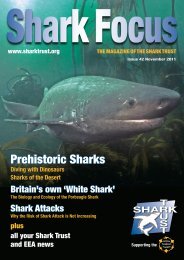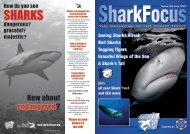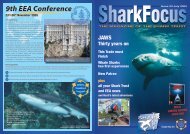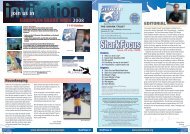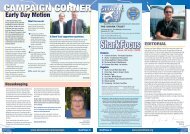Shagreen Ray Leucoraja fullonica - The Shark Trust
Shagreen Ray Leucoraja fullonica - The Shark Trust
Shagreen Ray Leucoraja fullonica - The Shark Trust
Create successful ePaper yourself
Turn your PDF publications into a flip-book with our unique Google optimized e-Paper software.
COMMON NAMES<br />
<strong>Shagreen</strong> <strong>Ray</strong> <strong>Leucoraja</strong> <strong>fullonica</strong><br />
<strong>Shagreen</strong> <strong>Ray</strong>, <strong>Shagreen</strong> Skate, Fuller´s <strong>Ray</strong>, Fuller´s <strong>Shagreen</strong> <strong>Ray</strong>,<br />
Raie-Chardon, Rough Flapper, French <strong>Ray</strong>, Raie Chardon (Fr), <strong>Ray</strong>a<br />
Cardadora (Es), Razza Spinosa (It), Kaardrog (Ne).<br />
SYNONYMS<br />
Raja <strong>fullonica</strong> (Linnaeus, 1758), Raja chagrinea (Shaw, 1804), Betaraia<br />
<strong>fullonica</strong> (Leigh-Sharpe, 1924).<br />
DISTRIBUTION<br />
Map base conforms with ICES grid squares.<br />
Text & Illustrations © <strong>Shark</strong> <strong>Trust</strong> 2009<br />
Dorsal View (♂)<br />
No Records<br />
Occasional<br />
Range<br />
Found in the east<br />
Atlantic from<br />
Murmansk in<br />
Russia to northern<br />
Morocco and out to<br />
Iceland. Also found<br />
in the western<br />
Mediterranean and<br />
out to the Islands of<br />
Madeira (Agustin,<br />
2009). Within<br />
British waters it is<br />
most common in<br />
the Celtic Sea and<br />
off north-western<br />
Scotland (CEFAS,<br />
2008).<br />
APPEARANCE<br />
• Maximum total length of 120cm.<br />
• Pronounced snout.<br />
• Upper surface plain ash grey.<br />
• Some patterning of transverse dark bands.<br />
Ventral View (♂)<br />
• White lower surface, sometimes dark under snout.<br />
• Rows of ~50 large thorns running down either side of midline.<br />
<strong>The</strong> <strong>Shagreen</strong> <strong>Ray</strong> has a rhomboid-shaped disc with sharply angled<br />
outer corners and an obvious, pronounced snout (Agustin, 2009).<br />
<strong>The</strong> teeth are arranged into 58–68 rows in the upper jaw. <strong>The</strong>se are<br />
pointed in both sexes (Clark, 1926).<br />
<strong>The</strong> dorsal surface of the disc is entirely spiny with a row of 50<br />
larger thorns on each side of the midline from the shoulder to the first<br />
dorsal fin. <strong>The</strong>se rows are much less prominent on older individuals as<br />
they wear down over time. Around the inner margin of the eye there<br />
is a complete row of eight thorns and there are small thorns on the<br />
scapular. Generally there are between three and nine thorns running<br />
in a longitudinal row on the upper part of the head. <strong>The</strong>re are no<br />
thorns between the close-set dorsal fins. <strong>The</strong> majority of the ventral<br />
surface of the disc is prickly, with the exception of the hind two-thirds<br />
of the pectoral fins (Whitehead et al., 1986).<br />
<strong>The</strong> colouration in adults is generally plain ash grey although<br />
there may be variable patterningof transverse dark bands. <strong>The</strong> ventral<br />
surface is always white. Unusually for an elasmobranch, the largest<br />
recorded male is larger than the largest recorded female, being 120cm<br />
and 111cm respectively (Agustin, 2009).<br />
RJF NT MED: DD<br />
NE ATL MED
SIMILAR SPECIES<br />
Amblyraja radiata, Starry <strong>Ray</strong><br />
<strong>Leucoraja</strong> circularis, Sandy <strong>Ray</strong><br />
Raja clavata, Thornback <strong>Ray</strong><br />
Raja microocellata, Small-eyed <strong>Ray</strong> (juv.) (not illustrated)<br />
Amblyraja radiata,<br />
Starry Skate<br />
Raja clavata,<br />
Thornback <strong>Ray</strong><br />
(Not to scale)<br />
Supported by:<br />
Text & Illustrations © <strong>Shark</strong> <strong>Trust</strong> 2009<br />
<strong>Shagreen</strong> <strong>Ray</strong><br />
<strong>Leucoraja</strong> <strong>fullonica</strong>,<br />
<strong>Shagreen</strong> <strong>Ray</strong><br />
<strong>Leucoraja</strong> circularis,<br />
Sandy <strong>Ray</strong>
TEETH<br />
<strong>Shagreen</strong> <strong>Ray</strong> <strong>Leucoraja</strong> <strong>fullonica</strong><br />
<strong>The</strong>re are 58 (young)–68 (adult)<br />
rows of teeth in the upper jaw.<br />
<strong>The</strong>se are pointed in both sexes<br />
(Clark, 1926).<br />
ECOLOGY & BIOLOGY<br />
HABITAT<br />
Very little is known of the ecology of the <strong>Shagreen</strong> <strong>Ray</strong> except<br />
that it is a demersal species found along continental shelves<br />
and inshore waters at depths of 30-550m (100–1,800ft) (Gibson<br />
et al., 2006). Records of catches from longline fisheries suggest<br />
that it has a preference for rough ground (Stehmann et al., 2000).<br />
It has been reported from Icelandic waters that a summer-time<br />
inshore migration occurs, more likely for feeding purposes then<br />
for spawning (Wheeler, 1969). <strong>Shagreen</strong> <strong>Ray</strong>s are by no means<br />
abundant in inshore waters and are not common across any of their<br />
range (Ellis et al., 2004).<br />
DIET<br />
It feeds on a variety of bottom dwelling species but most probably<br />
prefers fish and crustaceans (Zidowitz et al., 2008). Mature<br />
individuals of both sexes have sharp teeth indicating no significant<br />
differences in diet between the genders (Stehmann et al., 2000).<br />
REPRODUCTION<br />
Very little is known of the reproduction of the <strong>Shagreen</strong> <strong>Ray</strong><br />
except that it is oviparous and that the eggcases measure about<br />
80mm long (excluding horns) by 50mm wide (Whitehead et al.,<br />
1986). When breeding and laying occurs, the development time<br />
of the embryos and the size of the young at birth has not been<br />
determined.<br />
Text & Illustrations © <strong>Shark</strong> <strong>Trust</strong> 2009<br />
EGGCASE<br />
1. ~80mm in length (excluding horns).<br />
2. ~50mm in width (Whitehead et al., 1986).<br />
Similar eggcase to the Small-eyed <strong>Ray</strong>, Raja microocellata.
COMMERCIAL IMPORTANCE<br />
<strong>The</strong>re is no targeted fishery for the <strong>Shagreen</strong> <strong>Ray</strong> but it is caught<br />
and landed in multi-species trawls throughout its range and by<br />
longlines in the north (Gibson et al., 2006; Serena, 2005).<br />
THREATS, CONSERVATION, LEGISLATION<br />
As with most species of European skate and ray, the current trends<br />
and status of the population are difficult to determine. <strong>The</strong>re is<br />
definite potential for overfishing and CEFAS surveys have not<br />
recorded the species in the North Sea since 1998. It is still recorded<br />
by Scottish surveys though in small numbers and deeper than<br />
expected, such as along the edge of the continental shelf at around<br />
200m (655ft) (Gibson et al., 2006).<br />
All rajids are managed under a Total Allowable Catch (TAC)<br />
system in EU waters. Between 1999 and 2005 the 6,060t TAC was<br />
reduced by 47% and by a further ~50% from 2005 to 2008 (ICES,<br />
2008). Originally the TAC applied only to areas IIa and IV, however in<br />
January 2009 the TAC was extended to include ICES divisions IIa, IIIa,<br />
IV, VIa-b, VIIa-k, VII and IX. <strong>The</strong> table below gives a summary of the<br />
TAC’s for the years 2004 to 2009.<br />
ICES<br />
Division<br />
2004 2005 2006 2007 2009 2009<br />
IIa, IV 3,503 3,220 2,737 2,190 1,643 1,643<br />
IIIa N/A N/A N/A N/A N/A 68<br />
VIa-b,<br />
VIIa-c,<br />
VIIe-k<br />
Supported by:<br />
N/A N/A N/A N/A N/A 15,748<br />
VIId N/A N/A N/A N/A N/A 1,044<br />
VIII, IX N/A N/A N/A N/A N/A 6,423<br />
(All figures in tons. European Union, 2009)<br />
Since 2008 European countries have been required to record<br />
most skate and ray landings by species to give a clearer picture<br />
of the status of populations in EU waters (ICES, 2008). Some Sea<br />
Fisheries Committees (SFC) around the UK have byelaws which<br />
stipulate a minimum disc width (DW) for landed skates and rays,<br />
measured from the extreme tips of the pectoral fins. <strong>The</strong> SFC’s which<br />
implement these and the details are shown in the table below.<br />
SFC DW (cm) Other<br />
Cumbria 45 Cannot land wings less than 22cm in<br />
their maximum dimension<br />
Kent & Essex 40 Cannot land wings less than 19cm in<br />
their maximum dimension<br />
Southern 40 Cannot land wings less than 20cm in<br />
their maximum dimension<br />
South Wales 45 Cannot land wings less than 22cm in<br />
their maximum dimension<br />
States of 36<br />
Guernsey<br />
(Cumbria SFC, Unknown; Kent & Essex SFC, Unknown; South Wales<br />
SFC, Unknown; Southern SFC, 2006; NFFO, 2004)<br />
However, such localised management strategies are unlikely to<br />
be significant for the conservation of regional populations (Fowler<br />
et al., 2005). Many recreational anglers return any sharks, skates and<br />
rays they catch alive and some angling clubs have begun tag and<br />
release programmes (Holt, 2005). As with most European skate and<br />
ray species, there is very little effective management in place to<br />
protect the <strong>Shagreen</strong> <strong>Ray</strong>.<br />
Text & Illustrations © <strong>Shark</strong> <strong>Trust</strong> 2009<br />
IUCN RED LIST ASSESSMENT<br />
Near Threatened (2008).<br />
Data Deficient in Mediterranean.<br />
HANDLING AND THORN ARRANGEMENT<br />
• Handle with care.<br />
• Row of strong thorns on midline.<br />
• Row of thorns on head.<br />
• Orbital thorns.<br />
<strong>Shagreen</strong> <strong>Ray</strong>
REFERENCES<br />
<strong>Shagreen</strong> <strong>Ray</strong> <strong>Leucoraja</strong> <strong>fullonica</strong><br />
AGUSTIN, L. Q. 2009. <strong>Leucoraja</strong> <strong>fullonica</strong>. <strong>Shagreen</strong> <strong>Ray</strong>. Fishbase.<br />
www.fishbase.org.<br />
CEFAS. 2008. <strong>Shagreen</strong> Skate. www.cefas.co.uk.<br />
CLARK, R. S. 1926. <strong>Ray</strong>s and Skates: A Revision of the European<br />
Species. Fishery Board for Scotland. HM Stationary Office.<br />
Edinburgh, UK.<br />
CUMBRIA SFC. Unknown. Minimum Fish Sizes. www.cumbriasfc.<br />
org.uk.<br />
ELLIS, J. R., CRUZ-MARTÍNEZ, A., RACKHAM, B. D., ROGERS, S. I.<br />
2004. <strong>The</strong> Distribution of Chondrichthyan Fishes around the<br />
British Isles and Implications for Conservation. Journal of<br />
Northwest Atlantic Fishery Science, Vol. 35: 195-213.<br />
EUROPEAN UNION. 2009. Council Regulation (EC) No. 43/2009.<br />
Official Journal of the European Union, L22/1. www.mfa.gov.uk.<br />
FOWLER, S. L., CAVANAGH, R. D., CAMHI, M., BURGESS, G. H.,<br />
CAILLIET, G. M., FORDHAM, S. V., SIMPFENDORFER, C. A.,<br />
MUSICK, J. A. 2005. <strong>Shark</strong>s, <strong>Ray</strong>s and Chimaeras: <strong>The</strong> Status of<br />
the Chondrichthyan Fishes. IUCN SSC <strong>Shark</strong> Specialist Group.<br />
IUCN Publications. Cambridge, UK.<br />
GIBSON, C., VALENTI, S. V., FOWLER, S. L., FORDHAM, S. V. 2006. <strong>The</strong><br />
Conservation Status of Northeast Atlantic Chondrichthyans;<br />
Report of the IUCN <strong>Shark</strong> Specialist Group Northeast Atlantic<br />
Regional Red List Workshop. VIII + 76pp. IUCN SSC <strong>Shark</strong><br />
Specialist Group.<br />
HOLT, D. 2005 Common Skate Tagging Programme. <strong>The</strong> Scottish<br />
Angling Homepage: www.catchalot.co.uk.<br />
ICES. 2008. Demersal elasmobranches in the North Sea (Subarea<br />
IV), Skagerrak (Division IIIa), and eastern English Channel<br />
(Division VIId). ICES advice 2008, Book 6.<br />
KENT & ESSEX SFC. Unknown. Minimum Fish Sizes. www.<br />
kentandessex-sfc.co.uk.<br />
NFFO. 2004. Official Yearbook and Diary. Grimsby, UK.<br />
SERENA, F. 2005. Field Identification Guide to the <strong>Shark</strong>s and <strong>Ray</strong>s<br />
of the Mediterranean and Black Sea. FAO. Rome, Italy.<br />
SOUTH WALES SFC. Unknown. Byelaws. www.swsfc.org.uk.<br />
SOUTHERN SFC. 2006. Minimum Landings Sizes. www.southernsfc.<br />
org.uk.<br />
STEHMANN, M., BÜRKEL, L. 2000. Field Key to Common skate<br />
Species (Raja spp.) in Northern EC Shelf Waters. Grafik Design<br />
Studio GmbH. Hamburg, Germany.<br />
Text & Illustrations © <strong>Shark</strong> <strong>Trust</strong> 2009<br />
WHEELER, A. 1969. <strong>The</strong> Fishes of the British Isles and North-West<br />
Europe. Macmillan and Co Ltd. London, UK.<br />
WHITEHEAD, P. J. P., BAUCHOT, M. L., HUREAU, J. C., NIELSEN, J.,<br />
TORTONESE, E. (Eds.). 1986. Fishes of the Northeast Atlantic and<br />
Mediterranean. UNESCO. Paris, France.<br />
ZIDOWITZ, H., GEORGE, M., FORDHAM, S., KULLANDER, S. O.,<br />
PELCZARSKI, W. 2008. <strong>Shark</strong>s in the Baltic: Distribution, Use and<br />
Conservation of Cartilaginous Fishes in the Baltic Sea. <strong>The</strong> <strong>Shark</strong><br />
Alliance. www.sharkalliance.org.<br />
Text: Richard Hurst.<br />
Illustrations: Marc Dando.<br />
Citation<br />
<strong>Shark</strong> <strong>Trust</strong>; 2009. An Illustrated Compendium of <strong>Shark</strong>s, Skates, <strong>Ray</strong>s<br />
and Chimaera. Chapter 1: <strong>The</strong> British Isles. Part 1: Skates and <strong>Ray</strong>s.<br />
Any ammendments or corrections, please contact:<br />
<strong>The</strong> <strong>Shark</strong> <strong>Trust</strong><br />
4 Creykes Court, <strong>The</strong> Millfields<br />
Plymouth, Devon PL1 3JB<br />
Tel: 01752 672008/672020<br />
Email: enquiries@sharktrust.org<br />
For more ID materials visit www.sharktrust.org/ID.<br />
Registered Company No. 3396164.<br />
Registered Charity No. 1064185



